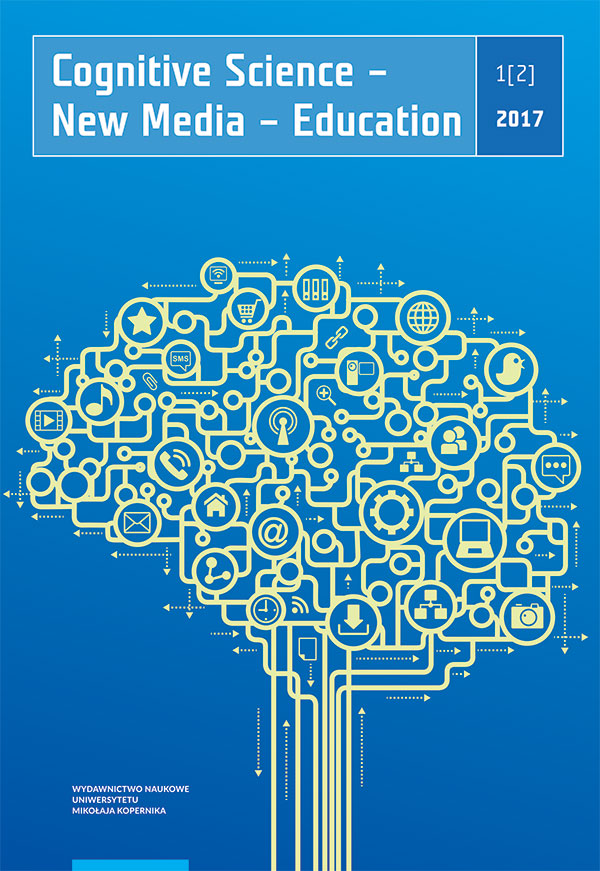Social media and social innovation
DOI:
https://doi.org/10.12775/CSNME.2017.003Ключові слова
social media, innovation, education, media literacy, democracy, interaction, new technologiesАнотація
All parts of human communication existence has been improved through the use of new media technologies and especially through the use of social media which is reflected directly and indirectly on social innovations sui generis. Social innovation should be the game of ideas of equal interaction of different subject using the special life within the life that exists in the virtual world of new technologies. To able to use social media in proper way within social innovation process we have to take into the account that social media are: cheapest form of interaction; accessibility – everybody can be involved within social innovation through social media networks – previously it was reserved only for the organizations well equipped with equipment and personnel. Social media can be used for producing opportunities for creative construction of a new model of citizen participation through education within social innovation process while, in the same time, journalists becomes a mediators of democratic participations of citizens. Social networks have emerged as a critical factor in information dissemination, search, marketing and influence discovery. The capacity of any society to create of steady flow of social innovations depends on a huge amount of presumptions even to be able to link and interact, in proper way, of social media and social innovation, but it is very difficult to control social media, regardless how skilled individuals are involved as a starting point of social innovation dissemination. So, where is the solution? Within the society as the whole, having in mind that manipulation should be replaced with transparency and responsibility of each step of social innovation process through social media. Why? The one word is the answer – it creates TRUST. Creation of transparency and responsibility is both, direct and indirect creation of the most important issues for the proper existence of society – TRUST in the existence system. The most important for connecting people, ideas and resources, within the field of the use of digital technology, are the intermediaries. Namely, those are the social networks which will connect people, ideas and resources for the social innovations, through social media and interacting with them. Of course, within Social media and Social innovations the most important intermediaries are the people, depending on their wishes and capabilities to do the change and to be a change – for the benefit of the society as the whole.
Посилання
Arthur W. B. (2009), The nature of technology: what it is and how it evolves, New York: Free Press.
Fromm E. (1941), Escape from Freedom, New York: Farrar & Rinehart.
Granovetter M. (1973), The strength of weak ties, “American Journal of Sociology”, No. 81, pg. 1287–1303.
Hadžialić S. (2007), Communicate instead devour, “BH JOURNALIST”, Bosnia and Herzegovina, No. 6, p. 32.
Lijphart A. A. (1999), Patterns of Democracy: Government Forms & Performance in Thirty-six Countries, New Haven: Yale University Press.
Machiedo M. (2013), INTERVIEW, “Vijenac”, No. 508–509, pg. 4–6.
Mulgan G., Tucker S., Ali R., Sanders B. (2007), Social Innovation. What it is, why it matters and how it can be accelerated. Said Business School, Skoll Center for Social Entrepreneurship, Working Paper, Oxford.
Newman L., Dale A. (2005), Network structure, diversity, and proactive resilience building: a response to Tomkins and Adger, “Ecology and Society”, Vol. 10, No. 1.
Osmančević E. (2009), Democratic way of WWW communication, Sarajevo: Friedrich-Hebert Stiffung.
Putnam R. D. (2000), Bowling alone: the collapse and revival of American community, New York: Simon & Shuster.
Rodin D. (1990), Beyond the free and censored press [in:] Conference proceedings “Journalism within the function of development”, Vinkovci: Novost.
Slaughter A. M. (2004), A new world order. Princeton, New York: Princeton University Press.
Vreg F. (1991), Democratic communication, Publishing house FON Sarajevo, Sarajevo, Bosnia and Herzegovina.
Internet sources
www.coi.gov.uk [access date: 20.04.2017]
https://www.youtube.com/watch?v=8iQLkt5CG8 [access date: 20.04.2017]
http://www.eurasiareview.com/15012016-world-of-globalsin-spin-as-conditio-sine-qua-non essay/ [access date: 19.05.2017]
http://www.diogenpro.com/introspicere_sabahudinhadzialic.html [access date: 8.03.2017]
http://diem25.org/assets/documents/diem25_english_long.pdf [access date: 19.05.2017]
http://www.indiana.edu/~t581qual/Assignments/Diffusion_of_Innovations.pdf [access date: 8.03.2017]
http://www.tepsie.eu/ [access date: 19.05.2017]
ACT Government Social Media Policy, http://www.cmd.act.gov.au/open_government/engage/social_media_policy [access date: 8.03.2017]
Bodin Ö., Crona B., Ernstson H. (2006), Social networks in natural resource management: What is there to learn from a structural perspective? “Ecology and Society” 11(2): r2, http://www.ecologyandsociety.org/vol11/iss2/resp2/ [access date: 20.04.2017]
David Icke, http://www.davidicke.com/ [access date: 19.05.2017]
Democracy in Europe Movement, http://diem25.org/ [access date: 8.03.2017]
Desouza K. C., Smmith K. L. (2014), Big Data for Social Innovation. Retrieved from:http://ssir.org/articles/entry/big_data_for_social_innovation [access date: 20.04.2017]
DiEM25, http://diem25.org/ [access date: 8.03.2017]
Disinfo, http://disinfo.com [access date: 19.05.2017]
DuPlessis VanBreda A., A Literature Review with special chapters on deployment resilience in military families & resilience theory in social work, 2001, http://www.vanbreda.org/adrian/resilience/resilience1.pdf [access date: 20.04.2017]
Duquette D. A. (2016). Hegel: SocialandPoliticalThought, http://www.iep.utm.edu/hegelsoc/ [access date: 8.03.2017]
Ecology and Society, http://www.ecologyandsociety.org/vol11/iss2/resp2/ [access date: 8.03.2017]
Gaist T. (2013). NSA Using Metadata to Compile „Social Network Diagrams“ on Americans, http://www.globalresearch.ca/nsa-using-metadata-to-compile-social-network-diagrams-on-americans/5352168 [access date: 20.04.2017]
Janrain, http://janrain.com/resources/white-papers/the-next-generation-of-social-innovation/ [access date: 8.03.2017]
Jimcarroll, https://www.jimcarroll.com/ [access date: 19.05.2017]
Lerman, K., Ghosh R. (2010). Information Contagion: an Empirical study of the Spread of News on Digg and Twitter Social Networks, [in:] Proceedings of 4th International Conference on Weblogs and Social Media (ICWSM), http://www.icwsm.org/2010/ [access date: 8.03.2017]
MG Siegler (2009). Celebrities + Twitter + A GoodCause = A RetweetExplosionTomorrow?, Posted Apr 24, 2009, http://techcrunch.com/2009/04/24/celebrities-twitter-a-good-cause-a-retweet-explosion-tomorrow/ [access date: 20.04.2017]
Moore M., Westley F. (2011), Surmountable chasms: networks and social innovation for resilient systems, “Ecology and Society” 16(1): 5, http://www.ecologyandsociety.org/vol16/iss1/art5/ [access date: 8.03.2017]
Social media policy, http://www.justice.vic.gov.au/utility/social+media/social+media+policy [access date: 8.03.2017]
Stanford Encyclopedia of Philosophy, http://plato.stanford.edu/entries/vico/ [access date: 8.03.2017]
The Courage Foundation, https://edwardsnowden.com/ [access date: 19.05.2017]
WikiLeaks, https://wikileaks.org/ [access date: 19.05.2017]
Wikipedia, I know that I know nothing, https://en.wikipedia.org/wiki/I_know_that_I_know_nothing [access date: 8.03.2017]
Wikipedia, Luddite, https://en.wikipedia.org/wiki/Luddite [access date: 20.04.2017]
Downloads
Опубліковано
Як цитувати
Номер
Розділ
Stats
Number of views and downloads: 498
Number of citations: 0



